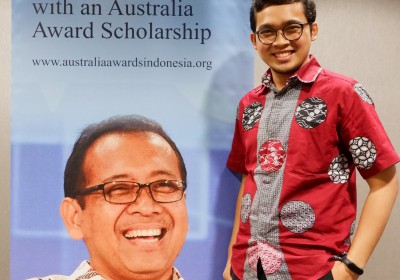Selected Speaker for IDF 2019: Muhammad Nabil Relies on AI and Cloud Computing for Aquaculture
November 12, 2019
Muhammad Nabil Satria Faradis
Internet of Things (IoT), smart-technology manufacturing, Artificial Intelligence (AI), and cloud computing can be blended into an Aquaculture 4.0 system as a breakthrough to develop aquaculture. A selected speaker for IDF 2019, Muhammad Nabil Satria Faradis, presented a breakthrough in the fisheries sector through his work entitled “Aquaculture 4.0: Transforming Indonesia’s Future Fisheries SMEs”.
“Aquaculture 4.0 was conceived as a recognised solution for aquaculture issues. Aquaculture 4.0 is implemented in digitalisation and automation strategies of the agriculture process,” said Nabil.
Nabil is the founder of a socio-technopreneur start-up company, PT. MINO Teknologi Indonesia (Ltd.), which brought him into one of the Top 50 Young Social Entrepreneurs, Singapore International Foundation 2017. In 2018, Nabil’s ideas won in the “From 13,000 Innovators” action held by the World Bank and Wharton School University of Pennsylvania, United States of America. His book entitled "Financing and Implementing the Sustainable Development Goals: Ideas for Action” was published by the World Bank.
Nabil explains aquaculture 4.0 as a system that links fish farmers as real-time users.
“Aquaculture 4.0 will provide recommendations that are expected to significantly improve the yield of aquaculture while conserving resources at the same time,” continued Nabil.
Aquaculture Life Cycle Treatment
The aquaculture cycle covers supplying materials, growth cycle, processing and packaging, distribution and storage, and consumption. Aquaculture 4.0 is intended to provide products in the form of sufficient and safe soil, water, energy consumption, and feed, using minimal resources. The aquaculture 4.0 system, according to Nabil, can help fish farmers recognise the quality of these aquaculture materials and produce aquaculture products that will sell out in the market.
Green energy must also be considered in implementing the aquaculture 4.0 system. Stakeholders need to monitor green energy, especially during the growth cycle and the aquaculture life cycle. All supply chain aspects of aquaculture products in this aquaculture 4.0 system must always consider green norms.
Aquaculture 4.0 has the vision to shape an aquaculture future that is sustainable, inclusive, and reliable for aquaculture fisheries Small and Medium Enterprises (SMEs) in Indonesia. This system will undoubtedly promote a significant and accountable aquaculture transformation.
Beyond technical issues, including the environmentally friendly factor, the implementation of aquaculture 4.0 also faces challenges in finance, operational, and management. Addressing these challenges demand innovative production models from fish farmers and new models from aquaculture companies.
Economic, Social, and Environmental Benefits
Intensive application of aquaculture 4.0 will bring benefits to fish farmer SMEs in terms of water quality monitoring, fish detection, feeding precision system, weather prediction, intensive resources, real-time data analysis, and control system. Fish farmers can monitor the growth environment, make the best production decision, and maintain optimal growth status. Implementing aquaculture 4.0 enables optimal control of water quality conditions, maintain the amount of oxygen, and preserve water quantity.
Nabil said that aquaculture 4.0 supports the livelihood of millions of Indonesian SMEs in both urban and rural areas. This initiative will serve as a strategic approach that increases the use of aquaculture resources to generate environmental, economic, and social benefits.
According to Nabil, the sustainability idea for aquaculture 4.0 emphasise on three sustainability development pillars. First, environmental benefits. Aquaculture 4.0 will make farmers implement ecosystem and environmental-based tactics for responsible aquaculture management. This approach is applied by managing and protecting ecosystem services using area-based methods and improving water quality as well as reducing waste side products.
This step provides an incentive system for using water and fish seeds. An intensive pond does not need further land clearing. New land clearings carry a risk of increasing environmental degradation. Aquaculture 4.0 also prioritises technological development using renewable energy sources and improves energy efficiency.
Second, economic benefits. Aquaculture 4.0 can support economic development and increase the production of SMEs in Indonesia by expanding the market, product, and trade access. Nabil mentions that aquaculture unlocks more employment opportunities, especially in the logistic system, and promote the improvement of transportation infrastructure. This system also generates plenty of opportunities for investors.
Third, social benefits. The people can take full advantage of aquaculture 4.0 to improve food security and nutrition, good jobs, livelihoods, and resiliency against various risks. Aquaculture 4.0 can be used to empower marginalised groups and create equal employment opportunities. The implementation of this aquaculture 4.0 system also improves safety and security for workers compared to the conventional system. This implementation of aquaculture 4.0 can provide good job opportunities in rural areas.
Nabil’s aquaculture 4.0 breakthrough work was presented on the Ideas and Innovations Marketplace, Co-Creating, and Collaborating session of the Indonesia Development Forum (IDF) 2019 on July 22. The topic regarding aquaculture 4.0 is the development of Subtheme 5: Developing Globally Competitive Micro, Small, and Medium Enterprises. This subtheme is a part of the main theme of IDF 2019: Mission Possible: Seizing the Opportunities for Future Work to Drive Inclusive Growth.
Indonesia’s Research Institutions Supporting the Development of the Electric Vehicle Industry
Indonesian Muslim Fashion and Cosmetics IKMs Shine at Dubai World Expo 2020
Govt Steps Up UMKM Transformation Efforts in the Midst of Pandemic Slowdown
Govt Encourages Promotion of IKM Products in Digital Era
Government Begins Developing Maritime Training Center in Makassar
Tweets by IDDevForum
